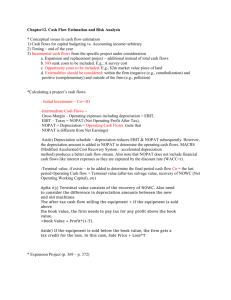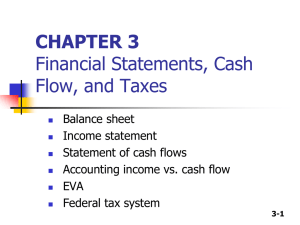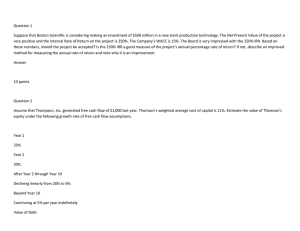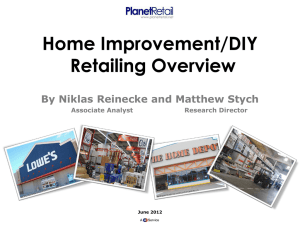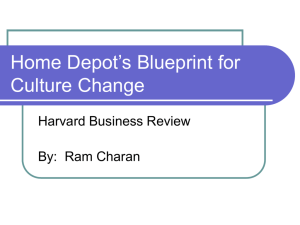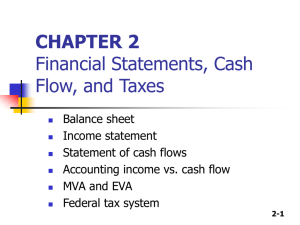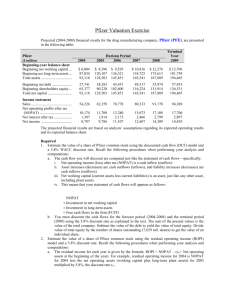HOME DEPOT , INC . In The New Millennium
advertisement
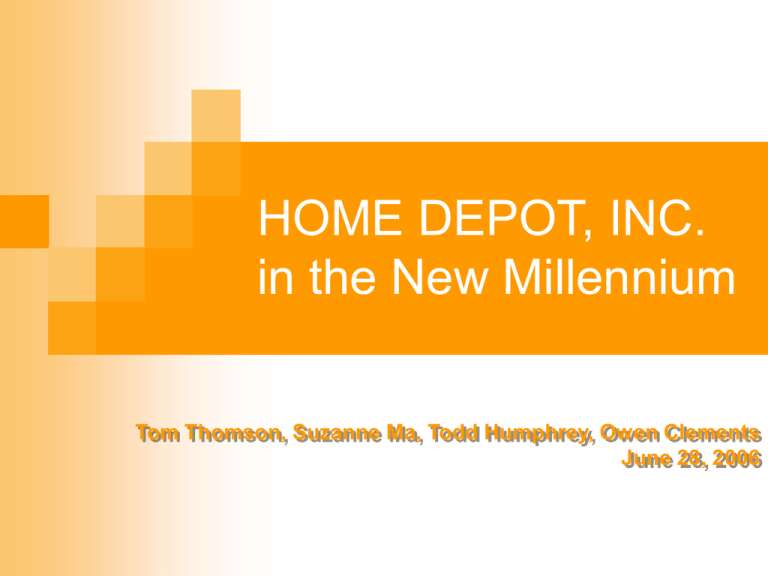
HOME DEPOT, INC. in the New Millennium Tom Thomson, Suzanne Ma, Todd Humphrey, Owen Clements June 28, 2006 Agenda Background/History Current situation Accounting and Finances Growth Initiatives Financial Analysis Forecast HOME DEPOT Inc. Founded In 1978 in Atlanta, Georgia Largest Retailer of home improvement products Stores were warehouses and sold large volumes of goods at low prices Offered ‘how-to-clinics’ and knowledgeable customer service representatives Between the Fall of 1981 & End of 1999, stock price had risen at a compound annual rate of 29% Uninterrupted growth in US economy since 1992 Competitors Lowe’s was second largest home improvement retailer Highly fragmented industry Menards and Homebase – smaller but concentrated in certain geographic areas Hechinger was main competitor initially but in an attempt to copy Home Depot’s warehouse style retail stores, went out of business Management Style Constantly evolving Evaluate new ideas on smaller scale before taking to entire store network Stores were located in all US states and Canadian provinces 2/3rd of stores opened in existing markets Current Situation October 12th, 2000 the company announced lower then expected earnings for the 3rd and 4th quarter Largest one day drop (28%) to $35, a $33 billion loss in market capitalization Drop thought to be due to slowing economy, overvaluation of stock price or problems with the company’s future strategic direction Economy had experienced uninterrupted growth since 1992 Trivia Time with Todd! What proportion of the world’s countries had a GDP in 2004 less than $33 billion according to the world bank? 2/3 1/3 1/2 5/8 11/16 Accounting Policies Point of Sale revenue recognition Cost as sold Perpetual inventory system Nothing interesting or exciting “Everything is Kosher” - Tom Growth Initiatives Classroom Opinions Buy it Yourself customers Professional customers Store format changes Product category expansion International growth Internet sales Growth Initiatives Buy-it-Yourself Customers Choose Products but Installed by Third-Party 6,200 third-party contractors Aging demographics Market for installation services estimated at $75 billion Less than 2% of the installation market Grow by 40% each year for the next five years Growth Initiatives Professional Customers Large Market potential ‘Job Lot’ quantities Different needs for different customers Effect of professional customers on DIY Anticipated to influence sales the most out of all of the initiatives More cyclical then DIY business Growth Initiatives Store Formats Extending into specialty shops Very high end product range Required retainer fee Sales goal for each customer ($10,000) Investigating smaller stores to compete more directly with Home Hardware etc. Growth Initiatives Product Categories Increasing product lines Adding appliances to complement current offerings Vertically integrate supply chain Tool rentals and truck rentals Growth Initiatives International Growth Expansion into South America Joint venture in Chile Looking into expansion into the Far East Growth Initiatives Internet Sales Information centre for customers Adding e-commerce abilities Intended to complement brick stores Talk Time with Tom! Small groups 10 minutes Evaluate each initiative individually Report back to us Growth Initiatives Buy-it-Yourself Customers Excellent opportunity! Service will be key for this segment Growth Initiatives Professional Customers Another opportunity! Largest and most profitable market Complement to the existing business Growth Initiatives Store Formats Bad idea! Different business plan Doesn’t fit well with current strategy and business plan Growth Initiatives Product Categories Great idea! One stop shopping is the N. American way Why deliver when you can charge the customer to do it themselves? Growth Initiatives International Growth Bad idea! Risky, risky, risky Saturate N. American market first Joint venture was the best method for entering this market Growth Initiatives Internet Sales Hard to set up Expensive to maintain Peak of the dotcom boom Catalogue site, not order site Financial Analysis Ratios 2000 1999 1998 Return on Equity 26.50% 22.70% 19.50% Return on Assets 22.60% 19.70% 17.40% Cash Flow from Operating Activities 2446 1917 1029 Cash Flows from Investing Activities -2622 -2271 -971 Cash Flows from Financing Activities 281 248 -32 Cash and Equivalents EOY 168 62 172 Cash Flow Forecast and Valuation Current Status: Trending 25%-27% growth. NOPAT of 6% Debt to Equity: 7% vs. 93% Decreasing stock value: $68 to $35. (From 12/99-9/00) What It Takes To Get $48.20? Observed price as of Feb 2001. Assumed flat NOPAT @6%. Equates to sales growth @29% What Will Be The Stock Price? OPTIMISTIC: 26% @ 7% NOPAT Continued growth with Do It Yourself Business. Expand stores. Expand categories. 40% growth in Buy It Yourself Customers. At least 25% growth with Professional Customers. Large opportunity, high margin. Stock Price= $60-$62 What Will Be The Stock Price? PESSIMISTIC: 5% @ 6% NOPAT Some continued growth with Do It Yourself Business via store expansions & bundling. Moderate success in Buy it Yourself Customers. Difficult to cross over with the Professional Customer base. Stock Price= $11 What Will Be The Stock Price? MOST LIKELY: 15% @ 6% NOPAT Some success with in Buy it Yourself Customers. Less so with Professional customers. Extension of products, services, and stores- allows some growth with the Do it Yourself Customers. Difficulties in trying to do it all. Share Price= $36 What Will Be The Stock Price? OTHER FACTORS Even with all the right initiatives future remains questionable. History: Very few companies can sustain HD’s level of performance over a long period. There may be limits to growth. After all, companies do trend toward the overall economy. What actually happened Management change Dec. 2000 Feb 2001 changed focus to quality Dec 2001 revised earnings down by ~40% July 2002 stock downgraded by M-L Lowe’s had outperformed for past 12 months Aug 2002 began hoarding cash Nov 2002 revenue missed growth predictions by ~50% And more… May 2003 6% increase in sales Revert away from warehouse style stores Centralized shipping Continue to expect 18-20 % growth Questions?


